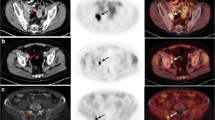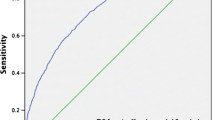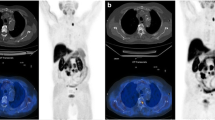Abstract
Purpose
To determine the diagnostic efficacy of 11C-choline PET/CT in patients with prostate cancer (PC) after radical prostatectomy who presented with increasing PSA levels during follow-up in spite of being on hormone treatment (HT), and therefore showing HT resistance.
Methods
We evaluated a large series of 157 consecutive PC patients previously treated by radical prostatectomy who presented with biochemical recurrence with increasing PSA levels in spite of ongoing HT (HT-resistant patients). At the time of 11C-choline PET/CT, the mean value of trigger PSA level was 8.3 (range 0.2 – 60.6 ng/mL), the mean PSA doubling time (PSAdt) was 5.3 (range 0.4 – 35 months), and the mean PSA velocity (PSAvel) was 22.1 ng/mL/year (range 0.12 – 82 ng/mL/year). 11C-Choline PET/CT was performed following a standard procedure at our centre to investigate increasing PSA levels, either as the first imaging procedure or in patients with negative conventional imaging. At the time of 11C-choline PET/CT all patients were receiving HT (61 were receiving monotherapy and 96 multidrug therapy). PET-positive findings were validated by: (a) transrectal US-guided biopsy in patients with recurrence in the prostatic bed, (b) surgical pelvic lymphadenectomy, (c) other imaging modalities, including repeated 11C-choline PET/CT, performed during a minimum follow-up of 12-months.
Results
11C-Choline PET/CT showed positive findings in 104 of the 157 patients (66 %). 11C-choline PET/CT detected: a single lesion in 40 patients (7 in the prostate bed, 10 in lymph nodes, 22 in bone, 1 at another site); two lesions in 18 patients (7 in lymph nodes, 7 in bone, 4 in both lymph nodes and bone); three or four lesions in 7 patients (4 in lymph nodes, 2 in bone, 1 at another site); and more than four lesions in the remaining 39 patients (2 in the prostate bed, 12 in lymph nodes, 12 in bone, 11 in both lymph nodes and bone, 2 at other sites). In 11C-choline PET-negative patients, the mean values of trigger PSA, PSAdt and PSAvel were 3.8 ng/mL (range 0.2 – 11.9 ng/mL) 7.0 months (range 1.21 – 35 months) and 5.8 ng/mL/year (range 0.12 – 30.1) respectively, while in 11C-Choline-PET-positive patients they were 10.5 ng/mL (range 0.2 – 60.6), 4.4 months (range 0.4 – 19.7) and 15.9 ng/mL/year (range 0.5 – 82.0) respectively. The differences between PET-negative and PET-positive patients were statistically significant for all these parameters: trigger PSA, p < 0.01; PSAdt, p < 0.01; PSAvel, p = 0.03.
Conclusion
In our patient population, 11C-choline PET/CT was able to detect relapsed disease in a large proportion of HT-resistant PC patients during HT. These data, obtained in a large series, suggest that HT withdrawal before performing a 11C-choline PET/CT scan may not be necessary for the detection of recurrent disease if PSA levels are increasing and PSA kinetics are rapid.


Similar content being viewed by others
References
Kataja VV, Bergh J. ESMO Minimum Clinical Recommendations for diagnosis, treatment and follow-up of prostate cancer. Ann Oncol. 2005;16 Suppl 1:i34–6.
Freedland SJ, Presti Jr JC, Amling CL, Aronson WJ, Dorey F, et al. Time trends in biochemical recurrence after radical prostatectomy: results of the SEARCH database. Urology. 2003;61:736–41.
Han M, Partin AW, Zahurak M, Piantadosi S, Epstein JI, Walsh PC. Biochemical (prostate specific antigen) recurrence probability following radical prostatectomy for clinically localized prostate cancer. J Urol. 2003;169:517–23.
Chism DB, Hanlon AL, Horwitz EM, Feigenberg SJ, Pollack A. A comparison of the single and double factor high-risk models for risk assignment of prostate cancer treated with 3D conformal radiotherapy. Int J Radiat Oncol Biol Phys. 2004;59(20):380–5.
Roberts SG, Blute ML, Bergstralh EJ, Slezak JM, Zincke H. PSA doubling time as a predictor of clinical progression after biochemical failure following radical prostatectomy for prostate cancer. Mayo Clin Proc. 2001;76:576–81.
Sella T, Schwartz LH, Swindle PW, Onyebuchi CN, Scardino PT, Scher HI, et al. Suspected local recurrence after radical prostatectomy: endorectal coil MR imaging. Radiology. 2004;233:379–85.
Coakley FV, Teh HS, Qayyum A, Swanson MG, Lu Y, Roach 3rd M, et al. Endorectal MR imaging and MR spectroscopic imaging for locally recurrent prostate cancer after external beam radiation therapy: preliminary experience. Radiology. 2004;233:441–8.
Choueiri TK, Dreicer R, Paciorek A, Carroll PR, Konety B. A model that predicts the probability of positive imaging in prostate cancer cases with biochemical failure after initial definitive local therapy. J Urol. 2008;179:906–10.
Okotie OT, Aronson WJ, Wieder JA, Liao Y, Freedland SJ, Dekernion JB, et al. Predictors of metastatic disease in men with biochemical failure following radical prostatectomy. J Urol. 2004;171:2260–4.
Heidenreich A, Bastian PJ, Bellmunt J, Bolla M, Joniau S, Mason MD, et al. Guidelines on prostate cancer. Eur Urol. 2011;59(1):61–71.
Cimitan M, Bortolus R, Morassut S, Canzonieri V, Garbeglio A, Baresic T, et al. 18Ffluorocholine PET/CT imaging for the detection of recurrent prostate cancer at PSA relapse: experience in 100 consecutive patients. Eur J Nucl Med Mol Imaging. 2006;33:1387–98.
Husarik DB, Miralbell R, Dubs M, John H, Giger OT, Gelet A, et al. Evaluation of 18F-choline PET/CT for staging and restaging of prostate cancer. Eur J Nucl Med Mol Imaging. 2008;35:253–63.
Giovacchini G, Picchio M, Scattoni V, Garcia Parra R, Briganti A, Gianolli L, et al. PSA doubling time for prediction of [(11)C]choline PET/CT findings in prostate cancer patients with biochemical failure after radical prostatectomy. Eur J Nucl Med Mol Imaging. 2010;37:1106–16.
Castellucci P, Fuccio C, Nanni C, Santi I, Rizzello A, Lodi F, et al. Influence of trigger PSA and PSA kinetics on 11C-choline PET/CT detection rate in patients with biochemical relapse after radical prostatectomy. J Nucl Med. 2009;50:1394–400.
Picchio M, Messa C, Landoni C, Gianolli L, Sironi S, Brioschi M, et al. Value of 11Ccholine-positron emission tomography for re-staging prostate cancer: a comparison with 18Ffluorodeoxyglucose-positron emission tomography. J Urol. 2003;169:1337–40.
Pascali C, Bogni A, Itawa R, Cambiè M, Bombardieri E. [11C]Methylation on a C18 Sep-Pak cartridge: a convenient way to produce N-methyl-11Ccholine. J Labelled Comp Radiopharm. 2000;49:195–203.
Khan MA, Carter HB, Epstein JI, Miller MC, Landis P, Walsh PW, et al. Can prostate specific antigen derivatives and pathological parameters predict significant change in expectant management criteria for prostate cancer? J Urol. 2003;170:2274–8.
Hara T, Kosaka N, Kishi H. PET imaging of prostate cancer using carbon-11-choline. J Nucl Med. 1998;39:990–5.
Krause BJ, Souvatzoglou M, Tuncel M, Herrmann K, Buck AK, Praus C, et al. The detection rate of 11Ccholine-PET/TC depends on the serum PSA-value in patients with biochemical recurrence of prostate cancer. Eur J Nucl Med Mol Imaging. 2008;35:18–23.
Soyka JD, Muster MA, Schmid DT, Schick U, Miralbell R. Clinical impact of 18F-choline PET/CT in patients with recurrent prostate cancer. Eur J Nucl Med Mol Imaging. 2012;39:936–43.
DeGrado TR, Coleman RE, Wang S, Baldwin SW, Orr MD, Robertson CN, et al. Synthesis and evaluation of 18F-labeled choline as an oncologic tracer for positron emission tomography: initial findings in prostate cancer. Cancer Res. 2001;61:110–7.
De Waele A, Van Binnebeek S, Mottaghy FM. Response assessment of hormonal therapy in prostate cancer by [11C]choline PET/CT. Clin Nucl Med. 2010;35:701–3.
Giovacchini G, Picchio M, Coradeschi E, Scattoni V, Bettinardi V, Cozzarini C, et al. [(11)C]choline uptake with PET/CT for the initial diagnosis of prostate cancer: relation to PSA levels, tumour stage and anti-androgenic therapy. Eur J Nucl Med Mol Imaging. 2008;35:1065–73.
Fuccio C, Schiavina R, Castellucci P, Rubello D, Martorana G, Celli M, et al. Androgen deprivation therapy influences the uptake of 11C-choline in patients with recurrent prostate cancer: the preliminary results of a sequential PET/CT study. Eur J Nucl Med Mol Imaging. 2011;38:1985–9.
Giovacchini G, Picchio M, Coradeschi E, Bettinardi V, Gianolli L, Scattoni V, et al. Predictive factors of [(11)C]choline PET/CT in patients with biochemical failure after radical prostatectomy. Eur J Nucl Med Mol Imaging. 2010;37:301–9.
Castellucci P, Fuccio C, Rubello D, Schiavina R, Santi I, Nanni C, et al. Is there a role for 11C-choline PET/CT in the early detection of metastatic disease in surgically treated prostate cancer patients with a mild PSA increase <1.5ng/ml? Eur J Nucl Med Mol Imaging. 2011;38:55–63.
Conflicts of interest
None.
Author information
Authors and Affiliations
Corresponding author
Rights and permissions
About this article
Cite this article
Ceci, F., Castellucci, P., Mamede, M. et al. 11C-Choline PET/CT in patients with hormone-resistant prostate cancer showing biochemical relapse after radical prostatectomy. Eur J Nucl Med Mol Imaging 40, 149–155 (2013). https://doi.org/10.1007/s00259-012-2272-z
Received:
Accepted:
Published:
Issue Date:
DOI: https://doi.org/10.1007/s00259-012-2272-z




